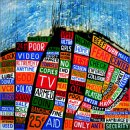As promised, a few more words about yesterday’s concert. But first a word about setlists. Elvis has such a deep back catalogue that anyone who claims to know every song he’s done is either lying or has very deep pockets. Or at least that’s my story. So I apologize when I will inevitably omit some songs from my retelling of the show.
Elvis opened the show with “45,” my favorite from his second to most recent album, When I Was Cruel. “Green Shirt” was next, then two other relatively uptempo songs. But most of the session was dominated by ballads, mostly drawn from North.
Mostly, but not all; Elvis’s performance of “This House is Empty Now” from his collaboration with Burt Bacharach brought the house down. Stripping away the layers of cheese-pop instrumentation that bloated the original recording, this version was just acoustic guitar, the magic touch of Steve Nieve on piano, and voice. And what a voice. Elvis stepped out from behind the mic after effortlessly nailing the high note in the bridge and sang the rest of the song unamplified. The performance brought the audience to their feet—remember, this was only about half a dozen songs into his set.
Incidentally, Elvis repeated the stepping away from the microphone trick a few more times during the set, which gave me a chance to notice that his unamplified voice was more in tune than his amplified voice. Maybe they screwed up something in the monitors. The acoustic in Benaroya was something to behold, by the way. Partway through the encore (which lasted 90 minutes!) he sang “You Left Me in the Dark,” and you could hear a pin drop. To be precise, you could hear the ventilation system of the hall, and the collective intake of breath as he sang the last phrase.
About 45 minutes into the first set, a latecomer took her front row seat, and Elvis, who had been vamping a bit on the guitar, leaned over and said, “The story so far…” After the laughter died down, he said, “…we’ve played a lot of sad songs.” But it wasn’t all cabaret. Elvis brought down the house with a broadly played version of “God’s Comic,” which he interrupted after the second verse with a moment of acidly political stand-up. (Sample: “God is everywhere, like CNN. And CNN was at our hotel in Florida because Dick Cheney was there. I saw him headed for the all-you-can-eat buffet, and thought, ‘Oh no. What if he eats too much, has a heart attack and dies? Then there’ll be nobody running the country!’ (a beat) And they’ll have to prise his cold, dead hand out of the arse of that Texan puppet of his.”) And his deconstructed version of “Watching the Detectives,” which veered from cabaret to reggae to feedback-drenched Hendrix, was brilliant, as was the rockabilly shuffle version of “Pump It Up.”
Again: for my money, one of the two or three best concerts I’ve ever attended. Get tickets and go. Now. You’ll thank me later.

